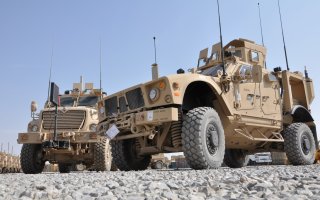The Pentagon Sucks at Acquiring New Weapons—but Only Most Of the Time
The Pentagon's acquisition process has been criticized for years as being overly bureaucratic, at times too slow, and in need of reform.
Here's What You Need To Remember: While most weapons developers completely agree with the assessment that the Pentagon's acquisition's process is need of reform, there have also over the years been many success stories wherein urgently needed platforms and systems were fast-tracked to war in life-saving fashion, with great results.
During the wars in Iraq and Afghanistan, the military needed new improvised explosive device (IED)-stopping vehicles and fast. These include Mine Resistant Ambush Protected Vehicles, Stryker vehicles with a road-side bomb-deflecting Double V-Hull, new body armor, robots and night vision goggles. All of these were all massively fast-tracked to the battlefield to meet the urgent needs from commanders, forcing the Pentagon’s acquisition system to adapt and respond with intensity.
Interestingly, this happened often yet this accomplishment is often overlooked given the longstanding chorus of criticism voiced about the Pentagon’s acquisition process. The Department of Defense’s acquisition process has been criticized for years as being overly bureaucratic, at times too slow, and in need of reform. While most weapons developers completely agree with this assessment, there have also over the years been many success stories wherein urgently needed platforms and systems were fast-tracked to war in life-saving fashion, with great results.
Various initiatives to streamline acquisition and closely connect it with pressing needs expressed from soldiers and commanders immersed in the dangers of war, came to fruition due to high-energy efforts at many points in recent years. The Army’s Stryker Double V-Hull, for instance, was massively fast-tracked through collaborative efforts between General Dynamics Land Systems and Army acquisition leaders. The vehicles were modified Stryker vehicles outfitted with a blast-deflecting underbelly to better protect soldiers facing lethal and at time catastrophic IED attacks in war.
U.S. Army innovators and weapons developers worked closely with industry to design new protective structures for the vehicles and integrate them into “flat bottomed” Strykers as a way to save soldiers’ lives. It worked. Hundreds of blast-deflecting infantry carriers and reconnaissance vehicles were sent to Iraq, a development which not only saved lives but also greatly improved mission effectiveness by helping to get troops to their mission objectives.
During this general timeframe, Army acquisition leaders also harnessed innovations in the areas of body armor to speed along stronger protective gear to soldiers and even add add-on pelvic armor to better safeguard lower extremities from ground blasts. The Army also worked quickly to get bomb-sniffing robots, such as the PacBot, to the war to give soldiers the opportunity to find and destroy IEDs without themselves being placed at risk. During the height of the Iraq counterinsurgency effort in 2007, for example, the Army found a way to deliver thousands of tele-operated mini bomb-tracking robots to combat.
All of these things were done carefully and safely, yet at a massively expedited pace in response to urgent need requests from the warzone. Army acquisition has for years been strengthening integration between the operational community, the procurement community and the Science and Technology community within the Army to synergize and connect promising new systems with soldiers facing enemy fire in war.
All of this is taking on new relevance in light of new efforts to incorporate more artificial intelligence, digital engineering, electronic warfare, and cyber resilience technologies more fully into the acquisition process.
What all of this amounts to is a simple, yet regularly unrecognized reality that although the acquisition system has for years been in need of continuous improvement, there have been years of defining successes.
Kris Osborn is the defense editor for the National Interest. Osborn previously served at the Pentagon as a Highly Qualified Expert with the Office of the Assistant Secretary of the Army—Acquisition, Logistics & Technology. Osborn has also worked as an anchor and on-air military specialist at national TV networks. He has appeared as a guest military expert on Fox News, MSNBC, The Military Channel, and The History Channel. He also has a Masters Degree in Comparative Literature from Columbia University.
Image: Reuters.
This piece first appeared last year and is being republished due to reader interest.

